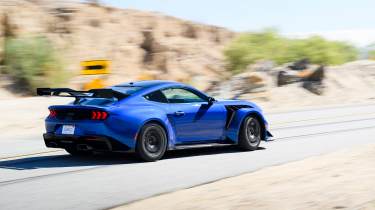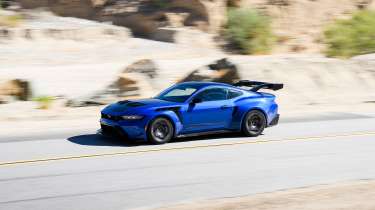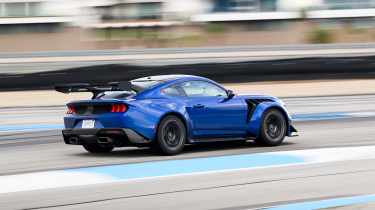Ford Mustang GTD 2025 review – nothing like a GT3 RS, but equally mesmerising
With the 815bhp, £315k Mustang GTD, Ford has approached the road-going track car concept in a uniquely American way. The results are superb
It takes one glance at the Mustang GTD to realise Ford hasn’t held back one iota in building a road-going track car to take on the likes of Porsche, McLaren and AMG. Not much can rival a GT3 RS for visual drama, but if anything the GTD goes even further – clearly a Mustang in its bones but muscled up into something cartoonishly angry and aggressive, like it’s stuck part-way through a Hulk transformation. Hunkered down on wide tracks, with its enormous rear wing and aero channels cleaved into the bodywork, you could mistake it for a de-stickered GT3 car. The exterior is just a snapshot of the engineering depth that’s gone into this project, because with the help of Multimatic (technical partner for the last Ford GT and the AMG One), every key element of the Mustang has been reworked to create an RS or Black Series-style road racer. Drivetrain, aero, chassis, you name it – it's all been pushed to the limit in a go-big-or-go-home American style, with a European mission in mind: to conquer the Nürburgring Nordschleife.
In this realm the GT3 RS is king, and you don’t beat it by copying it. The RS has been iteratively honed to such a high level that the chances of replicating its particular kind of magic are slim. The natural answer is to do something different, and since Ford already has a Mustang GT3 race car competing in IMSA (in the GT Daytona class – hence GTD) and GT World Challenge, it had the perfect source material for a road-going track car. Something inherently more brutal than a Porsche GT product but laser focused and uncompromising in its own way. Multimatic developed the racer and used learnings from this to create the GTD, with the aim of setting the first sub-7-minute lap around the Nordschleife by a US production car. Some seriously invasive surgery is needed to achieve that, which comes at a price – £315k to be precise, with 300-700 units being built per year globally, a very small number of which are coming to the UK in left-hand drive. To find out whether a Mustang can possibly be worth more than a well-specced McLaren 750S, we’re testing it for the first time near Palm Springs in California, initially on the road, then for a few laps of the Thermal Club race circuit.
More reviews
In-depth reviews
Reviews
- Hennessey Super Venom Ford Mustang review – can a Mustang handle 850bhp?
- Ford Mustang GT 2025 review – BMW M2 rival is the last manual V8
- Ford Mustang Dark Horse 2025 review – the last of a dying breed
- Ford Mustang Mach-E GT 2023 review – it’s fast, but is it fun?
- Ford Mustang Shelby GT500 UK review – how does Ford’s maddest muscle car handle Blighty?
- Ford Mustang Mach 1 (2021 - 2023) review – America’s BMW M4 gets track fit
> Porsche 911 GT3 RS 2025 review – the ultimate road and track car
The GTD starts life as a standard Mustang shell, but the front subframe is stiffened and a new rear structure is installed, to which entirely bespoke suspension is mounted. Up front is a multi-link set-up with an upper control arm instead of the usual MacPherson struts, and the rear gets a radical reconfiguration with horizontally mounted inboard coilovers. These use Multimatic DSSV (Dynamic Suspensions Spool Valve) dampers and two springs with different rates – the softer of the two can be fully compressed and locked out in Track mode, dropping the right height by 40mm at the front and 30mm at the rear. The units need to be mounted inboard for packaging reasons, which gives the added bonus of being able to watch the hardware at work through a window where the rear seats would normally be. Not if you’re the driver, obviously.
From the outside the GTD sounds biblical, even at idle. Close your eyes and you could almost be at a race meeting, the gritty V8 burble pulsing through the ground and silencing all conversation. The 5.2-litre unit has the bite to match that bark too, being derived from the previous-generation GT500 engine and supercharged up to 815bhp and 664lb ft. It’s dry-sumped to move it lower down and further back in the chassis, and gets a smaller supercharger pulley, a revised intake and titanium exhaust, and a fractionally higher rev limit than the GT500, now 7650rpm. Power won’t be neutered for the European market either, although the exhaust won’t be as loud on start-up or at low revs. The engine is hooked up to a carbonfibre propshaft and a Tremec transaxle at the rear; the GTD is auto-only but rather than the standard Mustang’s ten-speed torque converter, it gets an eight-speed dual-clutch with an e-LSD integrated into the same housing.
Wrapping everything up is a carbon body that’s been stretched over tracks that measure nearly four inches wider than a normal Mustang’s, with tricks to work the air throughout – including active flaps in the floor at the front and a movable DRS plane in the rear wing to trim drag when needed. The wing is quite a statement, as wide as a surfboard and attached to reinforced C-pillars rather than the bootlid in order to transfer load more directly to the rear tyres. The net result is 885kg of downforce at 180mph, pretty much on par with the GT3 RS (860kg at 177mph). The GTD’s beefier hardware actually makes it heavier than a Dark Horse at a hefty 1989kg, but that didn’t stop it smashing Ford’s sub-7-minute Ring target, with Multimatic works driver Dirk Müller posting a 6:52.072 in April. The GT3 RS is a chunk quicker still at 6:49.328, and Chevrolet’s Corvette ZR1X has since beaten it with a 6:49.275. But GTD engineers are keen to stress that the Nürburgring time is only part of this car’s story. It’s been developed to be rounded and useable on all types of track, and the road. ‘If setting the lap time was all we were trying to do, it’d be even faster there,’ says Ford Racing vehicle integration supervisor Keith Weston.
On average Palm Springs gets as little as five inches of rainfall per year, but today a freak thunderstorm has rolled in, almost flooding the surrounding roads and the circuit. So we head to the Santa Rosa and San Jacinto mountains to explore the GTD on the road first, in the hope the track clears up in the meantime. The anticipation is through the roof. Open the door and… oh. You're greeted by a normal Mustang interior: no roll-cage, no lightweight door panels, no fancy carbon buckets (the Recaros are borrowed from the previous-gen GT500). Ford doesn’t have a seat in its line-up that could be made from carbon without losing the side airbag and there isn’t an off-the-shelf roll-cage that can be installed into the GTD’s bespoke rear structure, but the ordinary cabin does break the road-racer illusion somewhat. It claws a few points back with the optional 3D-printed titanium paddleshifters, gear selector and chassis plate, which are made from melted-down F22 Raptor fighter jet parts.
Despite appearances, the GTD doesn't actually feel like a race car for the road to begin with. It's docile and tractable at low speed, the transmission smoothly shuffles between ratios, and you can relax into it as you would in a normal Mustang. But in the wild, you’re very quickly reminded that this is not a normal Mustang. Other traffic goes nuts at the sight of the GTD on the highway, stalking and circling to get a better look and throwing approving hand gestures. Squeeze the throttle for the first time and the GTD’s ferocity is equally eye-opening – at kickdown it explodes with almost surreal force and readily lights up the wheels on this wet surface, overlaid by a faint supercharger whine up front and NASCAR thunder behind. What an angry car.
That sensation will be familiar to those who’ve driven a souped-up Mustang, say a GT500, but what won’t be is the way the GTD tracks along with so much more precision and purpose. The slack you get in a Dark Horse has been removed and the nose follows your commands more crisply, which you notice even at town speeds. The steering rack has different gearing than that of a Dark Horse, but the wide tracks and new geometry must also play a part. Tyres, too; the mammoth 325 front and 345 rear Michelin Cup 2 Rs have been developed specifically for the GTD, and there can’t be many other road cars with as much rubber on the ground. Given their width they hunt around a little on poorly surfaced roads, but the GTD is happy at a calm cruise as we head for the hills.
The tuning of the Multimatic dampers changes according to the drive mode (Slippery, Normal, Sport, Track, Drag Strip and Custom) and by using spool valves to control the flow of fluid through the damper, they can precisely adapt to your inputs and the loads going through the car. Even set to their softest the GTD feels tautly controlled, but there’s a jagged edge to the way it tackles harsh imperfections, and poor surfaces fizz through the car. It adds to the sense of connection but UK roads will be a tougher test. So far the Mustang has only dealt with straight lines and right-angle turns, but as we leave the city behind things get much more interesting. The road starts to climb and sweep gently through the wilderness, and as the ascent steepens, the corners tighten and fold back on themselves. It’s the kind of stretch you’d relish in a hot hatch rather than a wide-body 815bhp Mustang, but the GTD is an absolute hoot. Predictable, trustworthy and a total sensory overload.
On a wet surface the intimidation factor is very real, but treat it with respect and the GTD doesn’t bite. It may be more focused in every sense but it still has the benign balance and approachability of a Mustang, just with the intensity and poise ramped up to new levels. On these twistier sections its reactions are slower than a GT3 RS’s and there isn’t the same sense of it pivoting rapidly around its centre on turn-in, but on the road there’s plenty to like about the GTD’s more measured approach. It doesn’t feel as heavy as it is, but it’s not a car that hides its bulk with uncannily fast responses (there’s no rear-wheel steering or active anti-roll bars), and that gives it an honest feel. You can drive it with calm hands and revel in the faithful front end, the support from the suspension and the endlessly entertaining V8, and it doesn’t feel like there are sophisticated electronics dictating the state of play.
But the GTD’s trick is that, as well as the usual sensory rewards you get in a normal Mustang, it can be hustled with a more attacking style, at which point it enters a new realm altogether. Switch to Sport, open the exhaust valves, back off the ESC and it’s a wild thrill, and this road is perfect for enjoying it. It keeps giving the harder you drive it, never running out of control and delivering flashes of excitement for corner after corner. Out of tight turns the V8 delivers a rich torrent of power that’s linear and precisely manageable, allowing you to hold the rear Michelins on the edge of slip – or just over if you’re feeling brave, tweaking your line with small twitches of throttle and kicking those wide hips out of line. The carbon-ceramic Brembos are a match for the power too, with progressive and reassuring pedal feel. It all comes together in an addictive, sustained rush. Would a manual add to the enjoyment? It’s not clear-cut. In a normal Mustang the extra interaction is welcome, but in the GTD there’s enough to keep you busy and totally absorbed, and the DCT is stellar – crisp on the way up, with a sharp crack of revs on the way down, which you can trigger over and over again, just for the hell of it.
With the roads almost dry we head to Thermal for a chance to fully unleash the GTD. Except we can’t. The Ford team is nervous about letting us out on Cup 2 Rs on a damp track, so arranges us in a ducks-and-drakes formation following an instructor in a Dark Horse for two five-minute sessions. Not the end of the world, but we’re also told that we can’t use the Mustang’s dedicated Track mode, because it loosens the stability control. Riding significantly higher with the softer road spring still in play means the aero and chassis won’t be working at their best, and the frustration is compounded when we head out to find a mostly dry track, with only the braking zone into the first corner requiring some caution.
On track, the GTD couldn’t be more different in character than a GT3 RS. With the proviso of not being in Track mode, it feels more conventional, less of an aero car. The approachability that makes it so enjoyable on the road is all there, but higher speeds require more management of the mass, whereas an RS feels absolutely dialled in, more communicative and takes fast corners in one surgical sweep. Maybe Track mode would unlock a similar feeling. Either way, the GTD is still a joy to hustle around a circuit and the fundamentals feel spot on, the limits clearly telegraphed and elastic. Feeling and hearing the V8 at full force for lap after lap doesn’t get old either. This could easily be a car where the power dominates everything, but in reality the rest of the package has been brought up to a level to let you manage and enjoy it.
The platform immediately feels wider, flatter and more stable than the Dark Horse, and that gives you scope to brake deeper and turn in harder as the car works all four tyres more effectively. Some patience is required to guide the nose into low-speed corners, but the excellent stopping power and feel from the Brembos allows you to help it into the apex, and adding power sets the car into a satisfying neutral stance, the rear squirming beneath you but finding great traction onto the next straight. Being more aggressive with the throttle results in the traction control killing the fun and your momentum, and not being in Track mode there isn’t a chance to utilise the GTD’s multi-stage TC. It feels like the GTD’s wilder side is itching to be explored, but that won’t happen today.
With limited dry running and compromised track time, it’s tricky to draw hard conclusions about the GTD for now, other than the fact that it totally got under our skin in the time we spent with it. It’s a car with a magnetic personality and engineering depth to back it up, and though one of its primary goals was to ruffle feathers at the Ring, when driving it, lap times are the last thing on your mind. You’re too busy having fun to worry about the stopwatch. An American GT3 RS? The GTD is something else entirely, and on this evidence, equally mesmerising.
Ford Mustang GTD specs
| Engine | 5.2-litre V8, supercharged |
| Power | 815bhp @ 7400rpm |
| Torque | 664lb ft @ 4800rpm |
| Weight | 1989kg (416bhp/ton) |
| Tyres as tested | Michelin Pilot Sport Cup 2 R |
| 0-62mph | 3.3sec (est) |
| Top speed | 202mph |
| Basic price | £315k |








